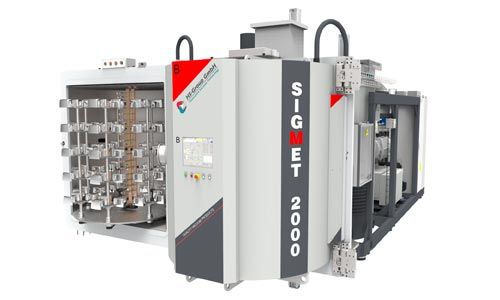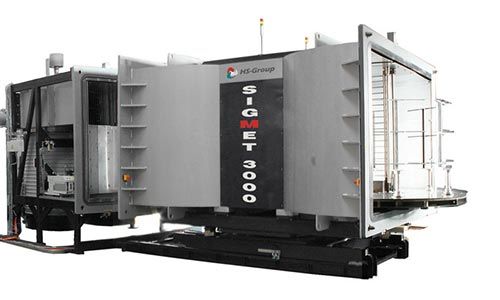- Home
- Products
- Vacuum systems
- SIGMET Series
SIGMET - Series
Deko / 3D Batch Coater
The systems of the SIGMET series are extremely flexible and optimized for uninterrupted 24-hour operation. The dual-door design allows the user to populate the planetary substrate holders in one door while the other door with substrates is in the coating process.
Metallizing
The term metallizing refers to the condensation (deposition) of a thin metal film on a substrate at a vacuum pressure of about 10-4 mbar. Vacuum pressure allows the metal molecules to move from the evaporation source to the surface to be coated while avoiding contact with air and other gas particles. Depositing aluminum on a product is the most commonly used method of industrial metallization.
The deposition of aluminum and other metals has an aesthetic and functional role. An estimated 60% of metallization applications are generally aesthetic, but with the progressive change of chrome plating coating processes that are both expensive and highly hazardous to the environment, functional type applications are increasing.
Application for the "automotive interior and exterior"
Car headlight eyebrows and reflectors or other plastic molded parts in the automotive industry are easily and quickly provided with a reflection layer by using vacuum coating methods. HS-Group coating systems of the type SIGMET, MAGMET or DELTALINE can be easily integrated into the production. Sputtering equipment, such as the MAGMET or DELTALINE systems, can even be linked directly to other stations, such as injection molding. The mirror layers applied in the vacuum systems are very thin, so that even temperature-sensitive types of plastic can be coated with coating methods such as vapor deposition, sputtering and the plasma CVD method.
In order to ensure the best adhesion properties, most engineering plastics are pretreated with a plasma glowing process in a vacuum. This serves to remove water vapor and to activate the surface. In the next step, a metal, usually aluminum, is applied to the substrate by the metallization process. As a third step, in the classical process, a protective layer is applied directly to the metal in a vacuum. This is where the plasma CVD technique comes into use, since this vacuum process does not require expensive environmental measures, such as those for painting equipment, paint sludge or solvent vapors. In order to proceed with this method, the same device as for plasma cleaning is sufficient. As a gaseous starting material, organic silicon compounds such as siloxanes are used, which are excited and fragmented in the plasma. This results in macro-molecular networks, which are evenly deposited as closed layers even on intricately shaped substrates. For the pure corrosion protection of aluminum mirror layers, for example on headlamp reflectors, layer thicknesses of 25 to 50 nm are sufficient. Wipe resistance can also be achieved with particularly hard, but still very thin polymer layer thicknesses. For the metallization of the molding, aluminium is used in automobile headlamps. Two vacuum coating methods are available: The classic vapor deposition method used in batch-operated single-chamber systems and the easy-to-automate sputtering process. This method produces headlamp reflectors in interlinked lines in the continuously operating MAGMET and DELTALINE systems.
Summing up, here again are the main process steps:
- Plasma treatment
- Metallizing with aluminium
- Plasma polymerization (in a single process)
The systems of the HS Group can combine a multitude of process steps through very high flexibility and thus respond to all customer needs. For example, even after the glowing process, a plasma polymerization can be interposed to improve adhesion and barrier properties.
HS-Group GmbH is your partner for the most demanding surface finishes.
The “PVD chrome plating” application
The galvanic chrome plating process is complex, expensive, and because of the heavy metal chrome, it is anything but environmentally friendly. However, the gloss of these surfaces is so fascinating that chrome is still a bestseller.
Attempts to achieve the chrome look without chromium-III or chromium-IV, so far led to both visually and functionally unsatisfactory results. In the meantime, this has changed completely. There are now coating processes that manage completely without heavy metals. Metal parts no longer have to be polished, and elements made of plastic can be “chrome-plated” permanently.
In order to produce a chromium-optical surface, a three-layer process is generally applied. This process consists of a base coat, which equalizes the substrate and serves as an adhesive layer for the following PVD coating (Physical Vapor Deposition). In principle, behind this process step is a separation of pure, previously evaporated aluminum on the parts’ surfaces. The final coating ensures the shine and mechanical robustness. The final coating also forms high-quality and precious surfaces on the complex 3D geometries, which are not inferior of the galvanically produced surfaces. It is also interesting that—in addition to high-gloss chrome—a matte version can be produced at the same cost, plus variants such as black chrome, bronze and colored anodized colors.
Typical applications for “PVD chrome plating” include fittings, wheel rims, vehicle components, hinges and furniture parts, and much more.
By the way: While the eye perceives it as chrome, the haptic perception is warm. This does not only apply to plastic substrates, also metallic substrates are perceived as “warmer” by the relatively thick coating. An irritation, which quickly fades away—and also opens up the way to new application methods.
Home | Contact | Imprint | Privacy Policy | Terms and conditions
2025 © HS-Group GmbH









